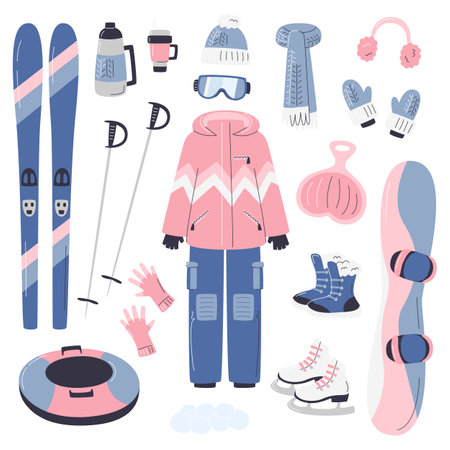1. Base Layers: Stay Dry from the Inside Out
When you’re hitting the trails in winter, what you wear closest to your skin can make all the difference between a great adventure and a miserable, chilly trek. The key is to stay dry—even when you’re working up a sweat. That’s where base layers come in.
Why Moisture-Wicking Matters
Base layers are designed to pull sweat away from your body, helping you avoid that clammy, cold feeling that comes when moisture sits on your skin. In the U.S., hikers often rely on two main types of materials for base layers: merino wool and synthetic fabrics like polyester or nylon.
Merino Wool vs. Synthetic Fabrics
| Material | Pros | Cons |
|---|---|---|
| Merino Wool | Excellent at regulating temperature Naturally resists odors Feels soft against skin |
Tends to be pricier Can take longer to dry if soaked |
| Synthetics (Polyester/Nylon) | Dries quickly More affordable Lightweight |
May retain odor Not as warm as wool in some conditions |
What to Avoid: Cotton
Cotton might be comfy at home, but it’s a no-go for winter hiking. Once cotton gets wet, it stays wet—which can leave you shivering on the trail. Always choose moisture-wicking fabrics for your base layer.
Tips for Choosing Your Base Layer
- Fit: Go for a snug but comfortable fit so the fabric can effectively wick away sweat.
- Weight: Lightweight for high-output activities; midweight or heavyweight for extra warmth on colder days.
- Layering: Make sure your base layer fits easily under additional clothing without bunching up.
The right base layer helps keep your core warm and dry, setting you up for safe and enjoyable winter hikes—no matter how chilly it gets outside.
2. Insulation: Lock in That Heat
Staying warm on a winter hike is all about smart insulation. This middle layer traps your body heat, keeping you comfortable even when the temperature drops and the wind picks up. Let’s break down your main options—fleece, down, and synthetic jackets—and help you figure out how to layer like a pro.
Understanding Your Insulation Options
| Type | Pros | Cons | Best For |
|---|---|---|---|
| Fleece | Lightweight, breathable, dries quickly, budget-friendly | Not windproof, less warm than down or synthetic when wet | Mildly cold days, high-output activities (like snowshoeing) |
| Down | Extremely warm for its weight, compresses well for packing | Loses warmth if wet unless it’s water-resistant treated; can be pricey | Very cold, dry conditions (think Rocky Mountain backcountry) |
| Synthetic | Keeps insulating even when wet, dries faster than down, usually cheaper than down | A bit bulkier and heavier than down, may not last as long | Damp climates (like Pacific Northwest), unpredictable weather hikes |
Layering Tips for Maximum Warmth
- Start with a base layer: Always wear a moisture-wicking base to keep sweat off your skin.
- Add insulation: Choose fleece for breathability during active hikes or down/synthetic for serious warmth.
- Don’t forget the shell: Top off your layers with a waterproof or windproof jacket to protect against the elements.
- Avoid cotton: Cotton holds moisture and will chill you fast—stick to technical fabrics.
- Adjust as you go: Layering lets you add or remove pieces depending on your activity level and the weather. If you start sweating, shed a layer before you get soaked!
Packing Pro Tip:
If you’re unsure what to bring, pack both a lightweight fleece and a puffy jacket. That way you can mix and match based on how cold it gets or how hard you’re working on the trail.

3. Outer Shells: Battle Wind, Rain, and Snow
When it comes to winter hiking in the U.S., your outer shell is your first line of defense against Mother Nature. The right jacket and pants keep you dry, block chilly winds, and protect you from snow, all while letting your body breathe. Choosing weather-resistant gear is key for safety and comfort on the trail.
Why Outer Shells Matter
Winter conditions can change fast—from biting wind to sudden snowfall or freezing rain. Outer shells act as a shield, helping you stay warm without overheating. Modern jackets and pants are designed with advanced fabrics that keep water out but allow sweat vapor to escape, so you won’t end up soaked from the inside.
Main Features to Look For
| Feature | Why It Matters |
|---|---|
| Waterproofing | Keeps you dry during rain or snowstorms. Look for jackets with a high waterproof rating (like Gore-Tex or similar technologies). |
| Windproofing | Blocks cold gusts that can chill you quickly, especially above tree line or in open areas. |
| Breathability | Lets sweat escape, preventing dampness inside your clothes which can make you cold. |
| Adjustable Hoods & Cuffs | Provides extra protection and lets you seal out drafts or loosen up for better airflow. |
| Pit Zips & Venting Options | Allows quick heat release during tough climbs without removing your jacket. |
| Lightweight & Packable | Makes it easy to stow your shell when it’s not needed or weather shifts unexpectedly. |
Pants Matter Too!
Don’t forget about your legs—water-resistant pants protect against wet brush, snow drifts, and icy winds. Look for features like full-length side zippers for easy on/off over boots and adjustable waists for layering flexibility.
Pro Tips for American Trails:
- Layer Up: Your shell works best as part of a system—combine with a base layer and insulation for max warmth.
- Pocket Check: Choose shells with easy-to-reach pockets for snacks, maps, or your phone—especially handy with gloves on.
- No Cotton! Stick to synthetic or wool layers under your shell; cotton holds moisture and can leave you feeling cold fast.
- Treat Your Gear: Use DWR (durable water repellent) spray to refresh older shells before heading out into heavy weather.
Selecting the right outer shell gear isn’t just about staying dry—it’s about hiking smarter, safer, and warmer all winter long.
4. Footwear and Accessories: From Head to Toe
When it comes to winter hiking, keeping your extremities protected is just as important as layering up your core. The right footwear and accessories can make or break your cold-weather adventure. Here’s what you need to know to stay safe and warm from head to toe on the trail.
Insulated, Waterproof Boots
Your choice of boots is crucial in winter conditions. Look for insulated, waterproof hiking boots with good traction. Insulation keeps your feet warm, while waterproofing prevents snow and slush from soaking through. Make sure the boots fit well—too tight, and your toes will get cold; too loose, and you risk blisters.
Wool Socks
Cotton socks are a no-go for winter hiking because they hold moisture. Instead, choose wool or synthetic blend socks that wick away sweat and keep your feet warm even if they get damp. Consider packing an extra pair in your backpack in case yours get wet during the hike.
Boots & Socks Quick Guide
| Item | Why It Matters | Recommended Features |
|---|---|---|
| Hiking Boots | Keep feet dry & warm | Insulated, waterproof, sturdy soles |
| Wool Socks | Retain heat even when wet | Merino wool, midweight, moisture-wicking |
Hats and Gloves
You lose a lot of body heat through your head and hands, so don’t forget to cover up. A beanie made of wool or synthetic material works well for most hikes. For gloves, consider wearing a thin liner glove under a thicker, waterproof outer glove. This gives you flexibility—if you start to overheat, you can remove a layer without exposing bare skin.
Gaiters
If youre trekking through deep snow or muddy trails, gaiters are a game-changer. These durable covers wrap around your lower legs and the tops of your boots to keep out snow, debris, and water. They’re especially helpful in powdery snow or when breaking trail.
Accessory Checklist for Winter Hikes
- Beanie or Warm Hat: Covers ears and retains heat
- Liner Gloves: Lightweight warmth and dexterity
- Waterproof Gloves or Mittens: Keeps hands dry and warm in wet conditions
- Gaiters: Shields lower legs from snow and debris
- Sunglasses or Goggles: Protect eyes from sun glare off snow
Dressing smart from head to toe ensures you’ll enjoy every mile of your winter hike without worrying about cold toes or numb fingers. With these essentials in your pack, you’ll be ready for whatever the trail throws at you!
5. Safety Add-Ons and Pro Tips
Must-Have Winter Hiking Gear for Safety
When hiking in the American winter, it’s not just about dressing warm—you’ll want to pack a few extra items to stay safe and enjoy your adventure. Here are some essentials that experienced hikers always recommend:
| Item | Purpose | Pro Tip |
|---|---|---|
| Traction Devices (like microspikes or crampons) | Add grip on icy trails and help prevent slips and falls. | Try them on your boots at home to make sure they fit well before heading out. |
| Trekking Poles | Improve balance and reduce strain on knees, especially on snowy or uneven ground. | Use snow baskets on poles in deep snow to keep from sinking in. |
| Emergency Blanket (Space Blanket) | Lightweight and compact, these keep you warm if you get stuck or need to wait for help. | Always keep one in your backpack—even on short hikes! |
| Headlamp with Extra Batteries | Winter days are short. A headlamp helps if you’re caught out after dark. | Chemical hand warmers can be taped to batteries in extreme cold to extend their life. |
| Personal Locator Beacon (PLB) or Satellite Messenger | Sends emergency signals if you’re out of cell service range. | If hiking alone or in remote areas, this can be a real lifesaver. |
The Leave No Trace Ethic
In the U.S., “Leave No Trace” is a big deal for all outdoor lovers. It means enjoying nature without leaving any sign that you were there. In winter, this includes:
- Packing Out Trash: Even food scraps like orange peels and nut shells should go home with you—they don’t break down quickly in the cold.
- Avoiding Trail Damage: Stick to marked trails, even if the snow makes it tempting to wander off. This protects fragile plants under the snowpack.
- Respecting Wildlife: Animals are stressed during winter, so give them plenty of space and never feed them.
- Burying Human Waste Properly: If you have to go, use a WAG bag or dig a cathole at least 200 feet from water sources.
Quick Safety Checklist Before You Head Out
- Check the weather forecast and avalanche warnings.
- Tell someone your route and expected return time.
- Pack extra layers, snacks, water, and all safety gear listed above.
- Know your limits—turn back early if conditions get tough!
Your Safe & Responsible Winter Hike Starts With Good Prep!
The right add-ons and a “leave no trace” mindset let you explore America’s winter trails safely—and help protect these wild places for everyone who follows in your footsteps.


